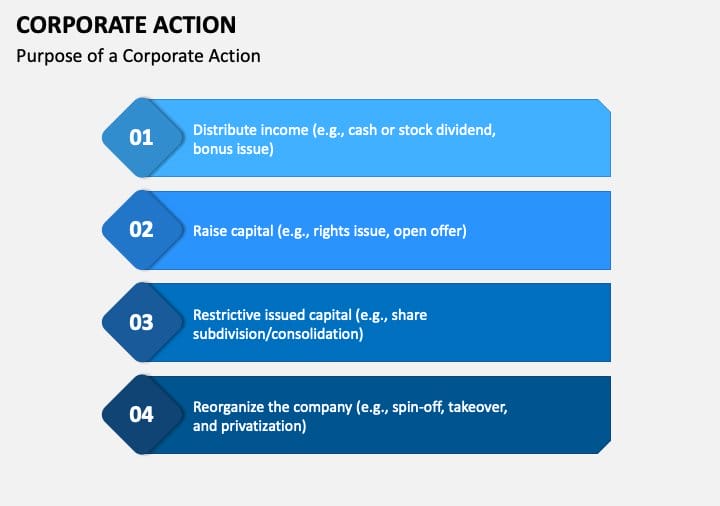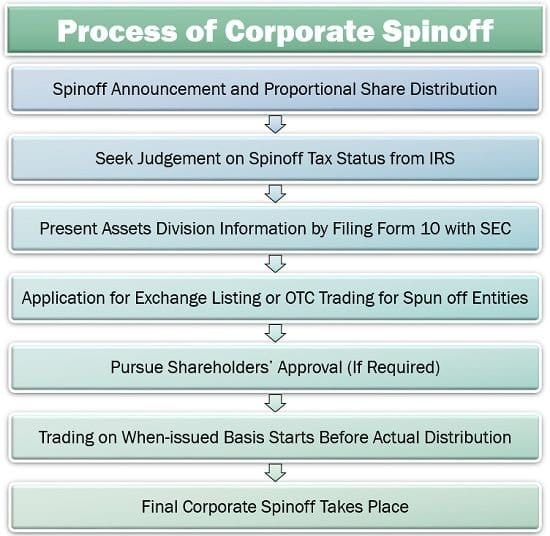Common Corporate Actions and What They Mean
Every publicly traded company serves as a business entity that can perform several actions that can influence assets, equities, and the marketplace.
While you may be aware of corporate actions like dividends, mergers, and acquisitions, there are other essential corporate actions you need to know.
If you have a great understanding of the common corporate actions, you can better position yourself to benefit from these actions.
This article explores everything you need to know about corporate actions, including specific real-life examples.
Let’s get started.
What Is Corporate Action?
Corporate actions refer to the various activities that directly impact the assets issued by a publicly traded company.
These actions can be a change in the company’s name, issuing dividends, or making a major restructuring move. Whatever these actions are, they directly affect the company and its shareholders.
According to the U.S. Securities and Exchange Commission (SEC), corporate actions include tender offers or exchanges, bankruptcy proceedings, and class actions.

How It Works
A corporate action is issued by a publicly traded company, starting a process that affects the securities issued by the company. Publicly traded companies are headed by a board of directors accountable for the corporate actions taken, most likely through a vote.
Corporate actions, whether mandatory or voluntary, require the input of the following parties:
- Stakeholders.
- Bondholders.
- Shareholders.
Approval for corporate actions happens through a voting process between directors and, in some cases, among the company’s shareholders.
Whatever form a corporate action takes, it has a direct line of influence on the movement of a company’s share price movement of a company.
Types of Corporate Actions
Corporate actions are a set of actions that require approval from the company’s board of directors and authorization from shareholders.
These sets of actions fall into two distinct categories: mandatory corporate actions and voluntary corporate actions. Here are the different types of corporate actions based on this classification.
Mandatory Corporate Actions
Mandatory corporate actions are those mandated by a company’s board of directors that affect all the company’s shareholders. Regulation bodies mandate that public company issuers notify the public about corporate actions announcements.
Here are some of the different types of corporate actions that fall under mandatory corporate actions.
1. Dividends
Dividends are a portion of a company’s post-tax earnings distributed as cash or stock to its shareholders. These payments, which are out of a company’s post-tax profits, are not fixed and vary similarly to a company’s share price.
One of the common types of corporate actions, dividends, has a huge effect on a company’s stock price. The board of directors is responsible for dividend payments, and it is paid according to an already predetermined time frame.
Dividends can either be a stock or cash dividend. In the case of the cash dividend, shareholders are paid a sum of money for the shares they own.
On the other hand, a stock dividend gives shareholders additional shares. For example, if a company announces a stock dividend of 50%, it means for every 2 shares you own, you get an additional share.

2. Stock Split
A stock split changes the number of shares owned by each stakeholder without affecting each stakeholder’s equity.
In simpler terms, when a company splits its stock, the number of shares owned by each stakeholder increases, but their actual value remains unchanged.
Otherwise known as a forward stock split, this type of stock split is initiated when a company feels its share price is too high and needs to pull in new stakeholders.
Stock splits involve slashing the prices of shares without affecting its stakeholders' equity value.
For example, a company decides to initiate a stock split in the ratio 5-for-1. If a shareholder holds 1,000 shares in the company before the stock split, at the end of the stock split, the number of shares will increase to 5,000 shares, but the equity value remains the same.

3. Reverse Split
A reverse split, also known as a reverse stock split, is the direct opposite of a stock split. In the case of a reverse stock split, a company reduces the number of its outstanding shares to increase its price per share.
Companies use this corporate action with the intention of increasing the prices of their shares. For example, a shareholder holds 20 shares in a company at a value of $20 before a reverse split is initiated.
Suppose the company decides to do a reverse split of 20-for-1. The shareholder now has only 1 share in the company, but still at a value of $20.

4. Mergers and Acquisitions
A merger is when two or more companies join their resources to form one company, bringing about material changes to all parties involved.
The goal of a merger is to create a new company where the assets of the former companies are combined and shareholders maintain their shares.
Acquisitions, on the other hand, is a type of corporate action that occurs when a company takes over shares of another company via a takeover bid.
The company that makes the bid is the acquiring company, while the company at the receiving end of the acquisition is the target company.
Mergers and acquisitions aim to limit competition or grow a business in a specific industry.

5. Spin-Offs
A spin-off occurs primarily with public companies and is initiated to refocus the activities of a part of the business. In a spin-off, an existing public company sells part of its assets or redistributes its shares in a bid to create a new independent company.
Existing shareholders of the breaking company get shares in the new company on account of their existing shareholdings, which is a mandatory event.

Voluntary Corporate Actions
Voluntary corporate actions are a set of actions that require the direct input of shareholders in decision-making. Unlike mandatory corporate actions, a response from the shareholders authorizes this set of actions.
Here are some examples of voluntary corporate actions.
1. Right Offerings
Right offering is a type of voluntary corporate action where a company has rights to existing shareholders, entitling them to buy additional shares.
This corporate action is a win-win situation for both parties as companies use this to raise money while shareholders increase their shares in the company.
Rights usually come with an expiration date, and the share prices are at a discount to the current market price. They can be transferable via the open market.
2. Open Offers
Open offers are the direct opposite of right offerings. In the case of an open offer, shareholders can buy ordinary shares at a company at a discounted price.
The catch to this offer is that the entitlement earned is not transferable or tradable, unlike those earned from the right offerings. This voluntary corporate action applies to existing shareholders.
Examples of Corporate Actions
Corporate actions occur in different forms for different, unique reasons. They occur either via a voluntary or mandatory event among the board of directors and shareholders of a company.
Here are some real-life examples of some common types of corporate actions.
1. Merger
One of the popular examples of a merger is the merger between Exxon and Mobil, two notable giants in the oil industry. The merger between these two oil giants led to the formation of Exxon Mobil, a combination of the assets of the two companies.
2. Acquisition
Another popular example of a corporate action is the case of the acquisition takeover of Mannesman by Vodafone in 2000. This acquisition is one of the largest takeovers in the history of the corporate world and was valued to be worth over $203 billion.
3. Stock Buybacks
Recently, through buybacks and cost cuts, Meta, formerly Facebook Inc., saw a rise of 23% in its stock prices. This rise was a result of the company announcing the buyback of $40 billion worth of stocks, a modern example of a corporate action that improves dividends.
Explore Further
- Stunning Corporate Websites
- Corporate Business Name Ideas Generator
- Different Types of Brands
- How to Start a Business With No Money
- Best Tools to Start Your Online Business
- Top IT Companies In The World
- Top Business Tycoons
- Types of Business Strategies